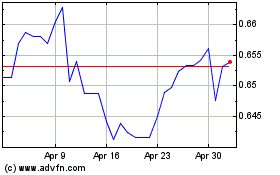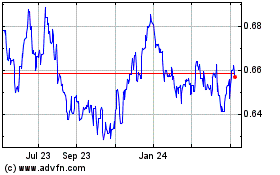U.S. Dollar Higher Ahead Of Trump's State Of Union Speech
February 05 2019 - 2:59AM
RTTF2
The U.S. dollar strengthened against its major opponents in the
European session on Tuesday, as investors awaited President Donald
Trump's State of the Union speech tonight and a speech from Fed
Chairman Jerome Powell on Wednesday for more clues about the
economy.
The President is expected to highlight his success over the last
two years and envision his agenda for next two years in his State
of Union speech, which had been delayed by a week due to a
government shutdown.
Trump is likely use his address to tout the strength of the US
economy, a key message in his looming 2020 reelection campaign.
Amid political stalemate in Washington, the President is
expected to call on Congress to come together on infrastructure
projects and his trade deal with Canada and Mexico.
Powell is scheduled to speak at a town hall meeting for teachers
in Washington at 7:00 pm ET Wednesday.
Speeches from Fed Vice Chair Richard Clarida, Cleveland Fed
President Loretta Mester, St. Louis Fed President James Bullard and
Fed Governor Randal Quarles are also due this week, whose remarks
will be watched for interest rate outlook.
The currency has been trading higher since Friday's U.S. January
jobs data, which showed a creation of 304,000 jobs versus
expectations for a gain of 165,000.
The currency held steady against its major opponents in the
Asian session, with the exception of the yen.
The greenback advanced to 1.2997 against the pound, its largest
since January 23. The greenback is seen finding resistance around
the 1.28 level.
Preliminary data from IHS Markit showed that UK service sector
growth slowed more-than-expected in January, moving closer to
stagnation, as new orders decreased for the first time in
two-an-a-half years.
The CIPS Services Purchasing Managers' Index, or PMI, dropped to
50.1 from 51.2 in December. Economists had forecast a score of
51.
The greenback that closed yesterday's trading at 1.1436 against
the euro firmed to a 5-day high of 1.1412. The greenback is poised
to target resistance around the 1.13 level.
Preliminary data from Eurostat showed that Eurozone retail sales
decreased at the fastest pace in over seven-and-a-half years in
December.
Retail sales, excluding automobile trade, declined 1.6 percent
from November, when they increased 0.8 percent, which was revised
from 0.6 percent.
The greenback bounced off to 110.04 against the yen, from a low
of 109.78 hit at 12:45 am ET. Next key resistance for the greenback
is seen around the 111.00 mark.
The latest survey from Nikkei showed that Japan services sector
continued to expand in December, and at a stronger pace, with a
services PMI score of 51.6.
That's up from 51.0 in November and it moves farther above the
boom-or-bust line of 50 that separates expansion from
contraction.
The U.S. currency appreciated to 1.0021 against the franc, a
level unseen since November 16, 2018. If the greenback rises
further, 1.02 is possibly seen as its next resistance level.
On the flip side, the greenback held steady against the kiwi,
after having declined to 0.6902 at 11:00 pm ET. The pair finished
yesterday's trading at 0.6884.
The greenback reached as low as 1.3102 against the loonie at
11:45 pm ET and held steady in subsequent deals. At yesterday's
close, the pair was worth 1.3110.
The greenback dropped to a 4-day low of 0.7264 against the
aussie, from an early 6-day high of 0.7194, and held steady
thereafter. The pair was valued at 0.7226 when it ended deals on
Monday.
The U.S. ISM non-manufacturing composite index for January is
scheduled for release in the New York session.
AUD vs US Dollar (FX:AUDUSD)
Forex Chart
From Mar 2024 to Apr 2024

AUD vs US Dollar (FX:AUDUSD)
Forex Chart
From Apr 2023 to Apr 2024
